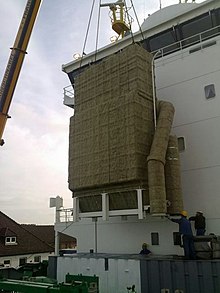Exhaust gas desulphurization in maritime shipping
Exhaust gas desulphurisation in shipping refers to the desulphurisation of the exhaust gases that arise when fuel is burned on board ships . Desulphurisation systems have recently been installed for this purpose. A distinction is made between “dry” and “wet” desulphurisation. The dry desulphurisation systems bind the sulfur compounds in lime substrates, which creates gypsum . The wet desulphurisation systems (so-called sulfur scrubbers ) known as gas scrubbers use salt water or fresh water with caustic soda .
Reducing sulfur emissions in shipping
Due to the increasing global environmental problems, the current developments in international shipping have led to stricter regulations, including for the permissible sulfur content in fuels. For this reason, the maximum permissible sulfur content in fuel in overseas transport was reduced in the first step from 5% to 4.5%, in the second step from 2012 to 3.5% and from 2020 or 2025 it is to decrease to 0.5%. For ports in the European Union , EU Directive 2005/33 / EC applies, which states that fuels with less than 0.1% sulfur must be used. For the Baltic and North Sea as ECA areas, the limit value of 1% sulfur applies, from 2015 0.1% sulfur.
These measures according to MARPOL Annex VI are "Rules for the prevention of air pollution by seagoing ships", they mean considerable changes for ship operation and significantly increased fuel costs. Instead of heavy oil , low-sulfur heavy oil and, from 2015, gas oil or low-sulfur marine diesel oil (MDO) must be bunkered in the ECA routes . As an alternative to low-sulfur fuel, the IMO and the EU also allow desulfurization of the exhaust gases if this is just as effective. The same sulfur oxide concentrations must be achieved with exhaust gas desulfurization as when operating with low-sulfur fuel (MEPC.184 (59)). The shipbuilding supply industry has already reacted and processes for dry and wet desulphurisation are currently in the test phase on seagoing ships of some environmentally conscious shipping companies .
implementation
According to estimates by DNV GL , 3,756 active ships and ships under construction had already installed desulfurization systems in September 2019. Most of them were equipped with open circulatory systems, in which the pollutants are not discharged into the air, but into the sea. For every ton of fuel burned, up to 45 tons of warm, acidic rinse water with various pollutants, including polycyclic aromatic hydrocarbons , is pushed outboard. The IMO regulations allow such systems, but the threat to marine life is considerable and countries like China have already banned the use of open circulation systems in their coastal waters.
Installation of a liquid scrubber
The Ficaria Seaways , a RoRo ship operated by DFDS Seaways , was drained in the floating dock of the MWB shipyard in Bremerhaven in 2009 and lengthened by 30 meters. Among other things, it was equipped with a sulfur scrubber, the “PureSOX” scrubber system from Alfa Laval , to remove sulfuric acid from the exhaust gas. The system was planned, installed and tested by MWB with the support of engineers from DFDS, Alfa Laval and MAN Diesel & Turbo . This makes this system one of the world's largest liquid sulfur scrubbers on board a ship. The scrubber system is called a hybrid system because it can be operated with both salt water and fresh water.
Dry desulphurization
The principle of dry desulphurization systems arose from the power plants on land. There the sulfur compounds are bound in milk of lime . Since the process cannot be implemented later on ships for reasons of space, lime granules with a huge “inner” surface are used. The lime granulate binds the sulfur compounds SO 2 and SO 3 , releasing water. A first test facility was implemented on the Timbus . It is a two-stage system with a silo and waste container.
As the first new building with a dry desulphurization system, the Flensburger Schiffbau-Gesellschaft designed and built a new and environmentally friendly ConRo ship for Oceanex Inc. in 2014 . The 200-meter-long ship with a load capacity of 19,500 tons has an ice class , is designed for worldwide travel and, due to its desulphurisation, was one of the most environmentally friendly ConRo ferries at the time.
See also
literature
- Jens Peter Hensen : Exhaust Gas Scrubber Installed Onboard MV Ficaria Seaways. Environmental Project No. 1429, 2012, Danish Ministry of the Environment, ISBN 978-87-92903-28-0 ( PDF file )
- Christoph Schladör , Horst Rulfs : Investigation of a dry process to reduce sulfur oxides in ship exhaust gases , 106th Annual General Meeting of the Shipbuilding Society , November 18, 2011 in Rostock
- Karl-Heinz Hochhaus: Exhaust gas desulphurization in shipping . In: Hansa , issue 6/2012
- Claudia Behrend: The scrubber - a success? In: Hansa , issue 5/2017, pp. 64/65
Web links
Individual evidence
- ↑ WillCrisp: "Thousands of ships fitted with 'cheat devices' to divert poisonous pollution into sea" The Independent of September 29, 2019
- ^ Ficaria Seaways ( Memento of March 9, 2013 in the Internet Archive ) , Alfa Laval.



